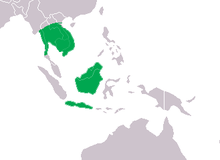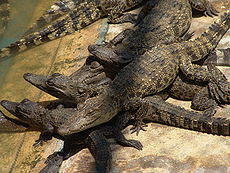- Siamese crocodile
-
Siamese Crocodile Siamese crocodiles Conservation status Scientific classification Kingdom: Animalia Phylum: Chordata Class: Reptilia Order: Crocodilia Family: Crocodylidae Genus: Crocodylus Species: C. siamensis Binomial name Crocodylus siamensis
Schneider, 1801
The Siamese crocodile (Crocodylus siamensis) is a freshwater crocodile native to Indonesia (Borneo and possibly Java), Brunei, East Malaysia, Laos, Cambodia, Burma, Thailand, and Vietnam. The species is critically endangered and already extirpated from many regions.
In the wild they prefer slow moving waters like swamps, rivers, and some lakes. Most adults do not exceed 3 m (10 ft) in length, although there are hybrids in captivity that can grow much larger. Pure, non-hybridised examples of this species are generally unaggressive towards humans and unprovoked attacks are unknown.[1]
Due to excessive hunting and habitat loss this crocodile is a critically endangered species. In 1992, it was believed to be extinct in the wild or very nearly so. Since then, a number of surveys have confirmed the presence of a tiny population in Thailand (possibly numbering as little as two individuals, discounting recent reintroductions), a small population in Vietnam (possibly less than 100 individuals), and more sizable populations in Burma, Laos and Cambodia. In March 2005, conservationists found a nest containing juvenile Siamese crocodiles in the southern Lao province of Savannakhet. There are no recent records from Malaysia, Brunei. There is known to be a significant population of the crocodiles living in East Kalimantan, Indonesia. Yayasan Ulin (The Ironwood Foundation) is running a small project to conserve an important wetland habitat in the area which is known to contain the crocodiles.[2] Most of them though live in Cambodia, where isolated, small groups are present in several remote areas of the Cardamom mountains, in the South west of the country, and also in the Vireakchey National Park, in the North East of the country. Fauna and Flora International is running a program in the district of Thmo Bang, Koh Kong province, where villagers are financially encouraged to safeguarding known crocodile nests. The Araeng river is considered to have the healthiest population of Siamese crocodiles in the world, although this may soon change after the completion of a massive dam in the Araeng river. Fauna and Flora international, in collaboration with several Cambodian government departments, is planning on capturing as many crocodiles as possible from this river and reintroducing them in another, ecologically suitable area, before the completion of the dam and the subsequent flooding of the whole area effectively renders their current habitat unsuitable. During the heavy monsoon period of June–November, Siamese crocodiles take advantage of the increase in water levels to move out of the river and onto large lakes and other local bodies of water, returning to their original habitat once water levels start receding back to their usual levels. It is believed that a smaller population also exists in the Ta Tay river, also in the district of Thmo bang. However, poaching is a severe threat to the remaining wild population in the area, with small specimens reaching hundreds of dollars in the black market, where they are normally taken into crocodile farms and mixed with other, larger species.[3] The total wild population is unknown, since most groups are in isolated areas where access is extremely complicated. A number of captively held individuals are the result of hybridization with the saltwater crocodile, but several thousand "pure" individuals do exist in captivity and it is regularly bred at crocodile farms; especially in Thailand.
In the Bang Sida National Park in Thailand, near Cambodia, there is a project to reintroduce Siamese crocodile into the wild. A number of young crocodiles have been released into a small and remote river in the park, not accessible to visitors.
The Phnom Tamao Wildlife Rescue Center in Cambodia conducted DNA analysis of 69 crocodiles in 2009, and found that 35 of them were purebred C. Siamensis. Conservationists from Fauna and Flora International and Wildlife Alliance plan to use these to launch a conservation breeding program in partnership with the Cambodian Forestry Administration.
Notes
- ^ Cox, M.J. van Dijk, P.P, Nabhitabhata, J and Thirakhupt, K. (2009) A photographic guide to Snakes and other reptiles of Thailand and South-East Asia. Asia Books Co. Ltd. Bangkok
- ^ http://www.speciesconservation.org/projects/Siamese-Crocodile/309
- ^ Associated Press:Endangered crocodiles hatched in Cambodia
References
- Crocodile Specialist Group (1996). Crocodylus siamensis. 2006. IUCN Red List of Threatened Species. IUCN 2006. www.iucnredlist.org. Retrieved on 11 May 2006. Listed as Critically Endangered (CR A1ac v2.3)
- Crocodylus siamensis - The Crocodile Specialist Group.
- Crocodylus siamensis - from the Biodiversity Heritage Library [1]
- Action Plan for Crocodylus siamensis. IUCN/SSC Crocodile Specialist Group - Status Survey and Conservation Action Plan, 2nd edition.
External links
- "Rare crocs back from extinction (video)". BBC. 5 February 2009. http://news.bbc.co.uk/1/hi/world/asia-pacific/7873550.stm.
- "New crocodile hope in Cambodia". BBC. 10 November 2009. http://news.bbc.co.uk/2/hi/asia-pacific/8351747.stm.
- "Saving the last Siamese crocodiles". Fauna and Flora International. http://www.fauna-flora.org/crocodiles.php.
Extant Crocodilian species Kingdom: Animalia · Phylum: Chordata · Class: Sauropsida · (unranked): Archosauria · Superorder: Crocodylomorpha Family Gavialidae Family Alligatoridae Alligatorinae
(Alligators)Caimaninae
(Caimans)Categories:- IUCN Red List critically endangered species
- Crocodilians
- Crocodylidae
- Fauna of Borneo
- Reptiles of Burma
- Reptiles of Cambodia
- Reptiles of India
- Reptiles of Laos
- Reptiles of Thailand
- Reptiles of Vietnam
- Reptiles of Asia
- Reptiles of Indonesia
- Reptiles of Malaysia
- Megafauna of Eurasia
Wikimedia Foundation. 2010.



